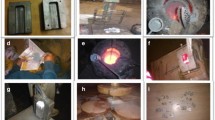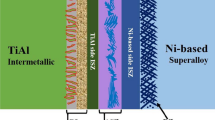Abstract
In this paper, the influence of surface roughness on microstructure and mechanical properties of AISI 4145 steel/WC-Co joint was investigated. Sessile drop test was conducted to evaluate the spreading behavior of Cu-Zn-Ni filler metal on the substrate with different surface roughness values. SEM micrographs were used to study the microstructure of interface and fracture surface while the mechanical properties of joint zone were compared by shear strength test. The sessile test reveals that an optimized roughness value is needed for the highest wettability. The sample with 0.36 μm surface roughness showed a minimum wetting angles of 15°/22°. The microstructure of filler metal/cemented carbide interface indicates that some defects such as micro-voids are produced when the surface of sample is too smooth. With the increase of surface roughness, the micro-voids disappeared which implies on the positive effect of roughness. However, the exceeding rise in roughness led to the further creation of micro-voids at the interface. Shear strength test also reveals that the defect-free samples show a ductile behavior while the flawed samples have the brittle failure. As a whole, it is indicated that an optimized surface roughness is required for achieving a high-quality brazed joint.








Similar content being viewed by others
References
Guo Y, Wang Y, Gao B, Shi Z, Yuan Z (2016) Rapid diffusion bonding of WC-Co cemented carbide to 40 Cr steel with Ni interlayer: effect of surface roughness and interlayer thickness. Ceram Int 42:16729–16737
Bonny K, DeBaets P, Perez Y, Vleugels J, Lauwers B (2010) Friction and wear characteristics of WC-Co cemented carbides in dry reciprocating sliding contact. Wear 268:1504–1517
Barrena MI, Gomez JM, Matesanz L (2010) Interfacial microstructure and mechanical strength of WC-Co/90MnCrV8 cold work tool steel diffusion bonded joint with Cu/Ni electroplated interlayer. Materials Design 31:3389–3394
Yu X, Zhou D, Yao D, Lu F, Xu P (2016) Fiber laser welding of WC-Co to carbon steel using Fe-Ni Invar as interlayer. Int J Refract Met Hard Mater 56:76–86
Lee W, Kwon B, Jung S (2006) Effects of Cr3C2 on the microstructure and mechanical properties of the brazed joints between WC-Co and carbon steel. Int J Refract Met Hard Mater 24:215–221
Chen H, Feng K, Wei S, Xiong J, Guo Z, Wang H (2012) Microstructure and properties of WC-Co/3Cr13 joints brazed using Ni electroplated interlayer. Int J Refract Met Hard Mater 33:70–74
Chen G, Zhang B, Wu Z, Feng X (2017) Microstructure transformation and crack sensitivity of WC-Co/steel joint welded by electron beam. Vacuum 139:26–32
Wang H, Yang D, Zhao X, Chen C, Wang Q (2005) Microstructure and bend strength of WC-Co and steel joints. Sci Technol Weld Join 10:167–168
Ju J, Xue F, Zhou J, Bai J, Sun L (2016) Interface and bond strength of brazing cemented carbide K20 to alloy steel AISI 4140 by high-frequency induction. Mater Manuf Process 31:1052–1060
Jiang C, Chen H, Wang Q, Li Y (2016) Effect of brazing temperature and holding time on joint properties of induction brazed WC-Co/carbon steel using Ag-based alloy. J Mater Process Technol 229:562–569
Amirnasiri A, Parvin N, Shafiei haghshenas M (2017) Dissimilar diffusion brazing of WC-Co to AISI 4145 steel using RBCuZn-D interlayer. J Manuf Process 28 (82–93
Shafiei Haghshenas M, Parvin N, Amirnasiri A (2017) Effect of bonding temperature on microstructure and mechanical properties of WC-Co/steel diffusion brazed joint. Trans Indian Inst Metals:1–10
Sui Y, Luo H, Lv Y, Fuxiang FW, Qi J, He Y, Meng Q, Sun Z (2016) Influence of brazing technology on the microstructure and properties of YG20C cemented carbide and 16Mn steel joints. Welding in the World 60:1269–1275
Zhang XZ, Liu GW, Tao JN, Shao HC, Fu H, Pan TZ, Qiao GJ (2017) Vacuum brazing of WC-8Co cemented carbides to carbon steel using pure Cu and Ag-28Cu as filler metal. J Mater Eng Perform 26:488–494
Zaharinie T, Huda Z, Izuan M, Hamdi M (2015) Development of optimum process parameters and a study of the effects of surface roughness on brazing of copper. Appl Surf Sci 331:127–131
Wulf E, Bachmann H, Möhwald K, Eifler R, Maier H (2014) The influence of brazing temperature and surface roughness on the wettability of reactive brazing alloys. Int J Mater Res (formerly Z Metallkd) 105:240–249
S. Kogi, T. Kajiura, Y. Hanada, Y. Miyazawa (2014) Wetting and spreading behavior of molten brazing filler metallic alloys on metallic substrate. IOP Conf Series: Materials Science and Engineering 61:012017
Vander Voort G, ASM Handbook (2017) Metallography and microstructures, vol. 9. 2004: ASM International
ASTM standard D1002 (2001) standard test method for apparent shear strength of singlelap-joint adhesively bonded metal specimens by tension loading (metal-to-metal). ASTM International, West Conshohocken, PA. https://doi.org/10.1520/D1002-01
Malijevský A (2014) Does surface roughness amplify wetting? J Chem Phys 141:184703
Ruckenstein E, Berim GO (2010) Microscopic description of a drop on a solid surface. Adv Colloid Interf Sci 157:1–33
Wenzel RN (1936) Resistance of solid surfaces to wetting by water. Ind Eng Chem 28:988–994
ASM International Handbook Committees, (1992), ASM handbook, volume 3, Alloy phase diagrams, MaterialsPark, OH: ASM International
Elsawy AH, Fahmy MF (1998) Brazing of Si3N4 ceramic to copper. J Mater Process Technol 77:266–272
Li Y, Liu W, Sekulic DP, He P (2012) Reactive wetting of Ag-Cu-Ti filler metal on the TiAl-based alloy substrate. Appl Surf Sci 259:343–348
Hong IT, Koo CH (2006) The study of vacuum-furnace brazing of C-103 and Ti-6Al-4V using Ti-15Cu-15Ni foil. Mater Chem Phys 94:131–140
Acknowledgments
We are thankful for the support of Taradis Tabesh Azma and CylinderSazi Tehran companies in this research.
Author information
Authors and Affiliations
Corresponding author
Additional information
Publisher’s Note
Springer Nature remains neutral with regard to jurisdictional claims in published maps and institutional affiliations.
Recommended for publication by Commission XVII - Brazing, Soldering and Diffusion Bonding
Rights and permissions
About this article
Cite this article
Amirnasiri, A., Parvin, N. & Haghshenas, M.S. Investigation of Surface Roughness Parameter in Dissimilar Diffusion Brazing of WC-Co to AISI 4145 Steel. Weld World 63, 1833–1840 (2019). https://doi.org/10.1007/s40194-019-00778-1
Received:
Accepted:
Published:
Issue Date:
DOI: https://doi.org/10.1007/s40194-019-00778-1




